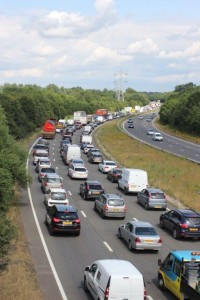 Abraham Lincoln
If given the truth, the people can be depended upon to meet any national crisis...
Abraham Lincoln
If given the truth, the people can be depended upon to meet any national crisis...
 Guildford news...
for Guildford people, brought to you by Guildford reporters - Guildford's own news service
Guildford news...
for Guildford people, brought to you by Guildford reporters - Guildford's own news service
Letter: More A3 Traffic Will Mean More Air Pollution
Published on: 24 Nov, 2015
Updated on: 24 Nov, 2015
From Roland McKinney
In response to the letter: My Suggestion For Reducing Guildford Traffic from Mike Pugh, I think it is worth bearing in mind that the one measuring point in the borough that measures air pollution beside the A3 is the only one in the borough that exceeds the relevant public health standard – and has done so over a period of years. This the air quality monitoring station at Wisley.
My point is that air pollution beside the A3 is measured at only one point in the borough, and this shows that pollution levels are higher than the level considered necessary to protect public health. Because of its location, this station underestimates air pollution at this point, probably by some considerable margin.
Bear in mind too that Public Health England has estimated that 55 people within the borough die each year as a direct consequence of air pollution from within the borough. So everyone pushing more traffic onto the A3 (which is surely already beyond its capacity in peak periods) is literally asking for more air pollution.
Should someone not be asking at what cost to public health?
Responses to Letter: More A3 Traffic Will Mean More Air Pollution
Leave a Comment Cancel reply
Please see our comments policy. All comments are moderated and may take time to appear. Full names, or at least initial and surname, must be given.
Click on cartoon for Dragon story: Public Asked for Views on SCC’s Proposal for Reduced Speed Limits



Recent Articles
- Notice: GTA German Filmfest – July 2
- Letter: We Need More Yellow Boxes and Enforcement
- Notice: What’s On in July at Guildford Cathedral
- Greenfield, Greenbelt Site Deemed ‘Greybelt’ by Planning Inspector
- Letter: WBC’s CIL Recommendations Are Too Little, Too Late
- Letter: Yellow Box Fines Are Just a Money-raising Opportunity for SCC
- Drivers Caught in Yellow Box Junctions at the Dennis Roundabout Paid £81k to SCC
- Residents Hit By CIL Fees Should Be Offered Full Review, Says Overview Committee
- Plans For New Guildford Preschool Rejected On Road Safety Grounds
- Expert in AI Is New Head of the University of Surrey


Recent Comments
- David Roberts on New Electric Trains Now Arriving at Guildford – 100 Years After the First One Did
- Mark Stamp on Greenfield, Greenbelt Site Deemed ‘Greybelt’ by Planning Inspector
- Simon Dickinson on Drivers Caught in Yellow Box Junctions at the Dennis Roundabout Paid £81k to SCC
- Paula Smith on Comment: What Are We To Make of the GBC Executive ‘Reshuffle’?
- Jim Allen on Drivers Caught in Yellow Box Junctions at the Dennis Roundabout Paid £81k to SCC
- Wayne Smith on Plans For New Guildford Preschool Rejected On Road Safety Grounds
Search in Site
Media Gallery
Dragon Interview: Local Artist Leaves Her Mark At One of England’s Most Historic Buildings
January 21, 2023 / No Comment / Read MoreDragon Interview: Lib Dem Planning Chair: ‘Current Policy Doesn’t Work for Local People’
January 19, 2023 / No Comment / Read MoreA3 Tunnel in Guildford ‘Necessary’ for New Homes, Says Guildford’s MP
January 10, 2023 / No Comment / Read More‘Madness’ for London Road Scheme to Go Ahead Against ‘Huge Opposition’, Says SCC Leader
January 6, 2023 / No Comment / Read MoreCouncillor’s Son Starts Campaign for More Consultation on North Street Plan
December 30, 2022 / No Comment / Read MoreCounty Council Climbs Down Over London Road Works – Further ‘Engagement’ Period Announced
December 14, 2022 / No Comment / Read MoreDragon Interview: GBC Reaction to the Government’s Expected Decision to Relax Housing Targets
December 7, 2022 / No Comment / Read MoreHow Can Our Town Centre Businesses Recover? Watch the Shop Front Debate
May 18, 2020 / No Comment / Read More







Bibhas Neogi
November 24, 2015 at 3:13 pm
It is true, more traffic means more exhaust gases but cars have got cleaner over the years and electric cars would no doubt help reduce the pollution gradually over the next decade and beyond. A3 capacity in some sections exceeds the designed volume of traffic during peak periods and hence leads to congestion.
When new housing is proposed close to the A3, access to it has to be assessed and if appropriate existing junctions should be used albeit by building connecting roads. Where this is not possible or causes other problems, a new junction is considered and built if it is technically possible and if it provides a cost-effective solution. If this cannot be done, the proposed housing scheme should be re-evaluated.
The number of cars on the road is likely to increase year on year unless travel patterns change appreciably with increasing use of electronics and on-line business and communications. Public transport could be vastly improved and made affordable, as on the Continent where fares are subsidised and paid from central taxation.
Road capacity will have to be increased if the increase in demand warrants it. So either new roads will have to be built or existing roads will have to be widened. Doing nothing is not an option as pollution would go on increasing.
London has congestion charging and limits emission within the protected zone. In future, maybe certain sections of the strategic network like the A3 would have tolls in order to limit the volume of traffic on it. What this really means is that roughly the same amount of pollution might be created but it would be diffused over a greater area as vehicles skirt round the charging zone.
Where level of pollution is a health concern, maybe that should be a factor when planning housing close to strategic routes.
Roland McKinney
November 25, 2015 at 6:58 pm
Bibhas Neogi suggests car exhausts have got cleaner – I think a few months ago VW engineers would have nodded sagely in response to this and their Audi colleagues might have said: “Vorsprung durch Technik” – but now might just hastily leave the room.
The simple truth is that air pollution is not improving, and has been more or less flat lining for several years. Although there are many reasons for that, a policy for the future cannot be based on anticipated improvements as we have seen they are simply not always there. VW being a case in point.
Even where public transport is good, it creates its own problems. London’s Oxford Street has the worst air quality in the UK, yet public transport vehicles predominate along Oxford Street.
It may be that the UK’s appalling air pollution is trying to tell us something – we have reached a natural limit in some areas. If that means that (for air quality/health reasons) development has to be limited in the borough and across the south east as a whole, then so be it.
There are areas outside the south east that would benefit economically from growth being transferred from the south east and where air quality problems are not the same. Guildford has a special problem as a gap town, which creates a host of specific problems with traffic and air quality.
John Robson
November 26, 2015 at 10:28 am
I believe owners of certain German cars may dispute your views on future pollution.
The A3 is at saturation point, that partially explains why the average speed in Surrey is 22mph. New housing at the levels projected means any additional road capacity will be utilised almost immediately. Furthermore, new housing will require new junctions, which statistically means more delays and more accidents.
It would nice to think that public transport would be subsidised but under the present government, that’s unlikely. The use of public transport, rail especially, is now an expensive luxury, but a necessity if you have to commute into London.
Most people don’t live near a railway station, so are still faced with a car or slow bus journey, but now any vision to free up capacity on the A3 is by taxing it and make it the preserve of the rich. Genius, you will also create numerous rat runs around Guildford for obvious reasons.
The government is suddenly awash with cash, when it suits, the A3, or soon to be M3 doppleganger, should be tunnelled or diverted around Guildford.
Anything else is just placing a sticking plaster over an axe wound.
The proposed improvements to the A3 are short-sighted. If we can find £23bn for a weapons system we’ll never use, surely we can find a £1bn for a tunnel we will use. I’m sure our MP is lobbying George Osbourne as we speak.
Ben Paton
November 24, 2015 at 9:07 pm
Cobham High Street – not far from the Wisley sensor – is an AQMA or Air Quality Monitoring Area. Elmbridge has an obligation to reduce air pollution on Cobham High Street.
http://uk-air.defra.gov.uk/aqma/details?aqma_id=399
Guildford should insist that more sensors are installed.
The A3 and M25 also cause significant noise and light pollution.
Mike Pugh
November 25, 2015 at 11:08 am
Roland McKinney’s comment about the impact of particulate air pollution on the health of Guildford residents is worthy of serious consideration in the development of a strategy for easing our chronic traffic problems.
At peak times, many of our main roads into and through Guildford are often at a standstill. Stop-start vehicles pump out particulates at a rate per mile far higher than smoothly moving traffic. I am sure that this would have been demonstrated in the portable pollution monitoring station that was set up at the end of Walnut Tree Close at the junction with the Gyratory some years ago.
The proposal to add a third lane to the A3 through Guildford would remove one of the most polluting traffic bottlenecks on the A3 in Surrey, and would provide added benefit to any additional links to/from the A3 aimed at relieving traffic congestion in and around the town.
If anyone wishes to study the PHE report that cites the 55 attributable deaths (per year, assessed as 5.7% of deaths over the age of 25 in the Borough) it may be found on its website in PHE-CRCE-010: Estimating local mortality burdens associated with particulate air pollution.
John Robson
November 25, 2015 at 2:54 pm
Mike Pugh says, “The proposal to add a third lane to the A3 through Guildford would remove one of the most polluting traffic bottlenecks on the A3 in Surrey…”
Really? How long would we feel this benefit for? Six months? Especially when the plan is to encircle Guildford with thousands of houses and thus add more cars to the 15,000,000 traffic movements on the A3 per annum.
Furthermore, after spending billions widening the M25, how long was it before it reverted to being the biggest car park in Europe?
We spend billions on transport infrastructure, coming up with the same tired solutions which don’t appear to be solving the problems. Someone needs to join the dots and provide a cohesive transport strategy or we will continue to have one of the most expensive and inefficient transport network in Europe.
Bibhas Neogi
November 26, 2015 at 8:36 am
It is true that part of the increased capacity by either widening or by building new roads is taken up by generated traffic but the percentage is small.
Unless draconian measures are taken to curb the growth in traffic, the consequence of doing nothing will be more pollution, waste of fuel, waste of productive time due to delays and ultimately wasted millions in national wealth.
We value our freedom and despise authoritarian state meddling in our affairs, so sensible and timely actions to keep the road network in keeping with the demand are necessary and failing to do that will only make matters more acute as is the case, for instance, on the A3 stretch of Guildford.
The need to improve the A3 through Guildford has been on the Highways Agency’s list of schemes from way back in the early 90s but unfortunately schemes have been pulled from the programme due to cut-backs. Let’s hope Highways England this time manages to keep the improvement scheme on track. So far the chancellor has not cut the roads programme.
A cohesive transport strategy must include affordable public transport, a more flexible working day by those who need not be in their work place during the core 9 to 5, more working from home or remote office facilities close to home, with all the facilities of a modern electronic office.
Adrian Atkinson
November 25, 2015 at 6:20 pm
Putting extra lanes will not solve the problems.
From the 1980s the great Ben Elton [a Guildford man] draws parallels with swing bins, rubbish and the proposed extra lanes on the M25 back then. More bins more rubbish, more lanes more cars – how true, how true.
So what is our so progressive society proposing now? Extra lanes.
Valerie Thompson
November 26, 2015 at 12:39 pm
The government needs to find the money to build a tunnel.
At present there are some houses beside the A3, near the Cathedral exit, within 20 yards or so, of the road. What must their pollution levels be?
Three lanes would speed up the traffic and lead to fewer idling engines, but will still bring pollution.
The suggestion that there be charging for this section, sending cars across country in order to avoid paying is absurd, as we are all aware of the narrowness of the lanes through nearby villages and estates. More cars going slowly along these roads would add to the pollution there instead of dealing with the problem in Guildford itself.
Terry Stevenson
November 27, 2015 at 2:38 pm
In respect to the tunnel idea – where will the traffic from Guildford that wants to join and leave the A3 go to access it?
I imagine there would be one major interchange at its start and another at its end. After all, I can’t recall seeing many subterranean interchanges anywhere recently to allow motorists to dive in and out mid-tunnel. I suppose you could then use the existing A3 ‘as a local distributor’ to go one way or t’other, or to bypass the tunnel during maintenance or incidents.
That said, I don’t imagine that it would greatly reduce traffic and pollution levels along the likes of Ladymead and other roads that would feed traffic towards the tunnel’s ends.
By-passing Hindhead using a tunnel is one thing, Guildford would be a whole different ball game. A proper bypass would be a much simpler and cheaper solution, albeit more visually intrusive and a great impact on land take and the green belt.
However, it would allow all the traffic wishing to join the A3 to be intercepted at various point along its length, without it having to be concentrated at either end of a tunnel, or as at present, at the restricted access junctions within Guildford.
Jim Allen
November 27, 2015 at 9:00 pm
A tunnel (for through traffic) would be a simple option. Starting at Gosden Hill Farm it would drop 40 metres under the Wey and emerge at Compton, five miles away, with interchanges at Potters Lane and Compton. Two land owners would be involved one of whom wants to develop his land.
The tunnel boring machines are currently ‘under London’ but will soon emerge and land is available along side the A3 at both ends.
A ‘by pass’ would involve 50 plus land owners, major opposition and considerable legal costs, over and above the tarmac.
Bibhas Neogi
November 28, 2015 at 9:08 am
The idea of a tunnel has been discussed in these columns a while ago.
A tunnel about 9km long would cost around £1,800 million based on the cost of Hindhead tunnel.
Tunnels are not pollution free. Exhaust gases have to be extracted and released into the atmosphere at intervals.
Where would these be located since the surrounding areas of these outlets would have concentration of polluting gases?
I think it is highly unlikely that the benefits would outweigh the cost of such a tunnel considering Guildford has two bypasses already!
It would be cost-effective and practical to widen the existing two-lane sections to three and improve the junctions on it.
We do not yet know what Highways England (HE) would be proposing for this stretch of the A3 but let us hope it finds the most appropriate solution.
The problem of the M25 is that it has been built too late between the rings C and D of the four ring roads identified way back in the thirties.
Dithering by successive governments has brought us this problem.
The A3 is also heading for the same problem if those like John Robson and Adrian Atkinson lightly discard that widening brings any benefits.
Even if a small percentage of traffic is generated, widening does reduce congestion and pollution but if intervention is delayed in widening and building new roads in keeping with the demand, congestion and pollution would go on increasing.
Maybe a third bypass would be needed and no doubt HE would be looking into such possibilities as part of its research into future growth and demand and take into account traffic due to additional housing around Guildford that might be built.